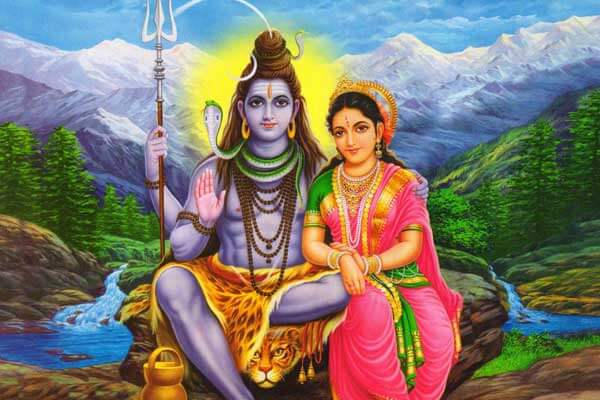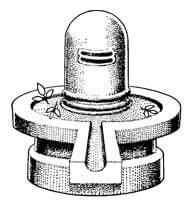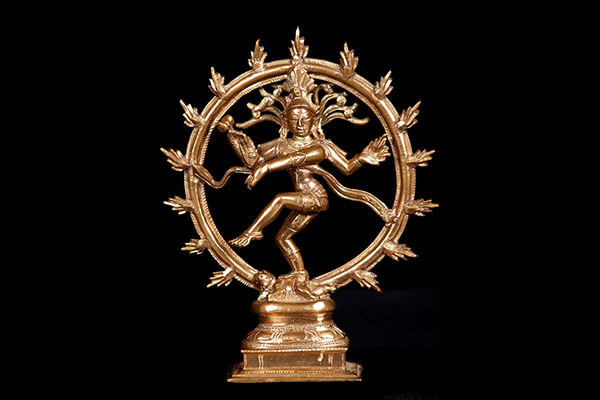This is a select collection of sayings on Lord Shiva taken from Amma’s messages, talks, and books.
Some believe that Lord Shiva is at Kashi alone or Lord Krishna is only in Brindavan. Dear children, do not think that God is confined to the four walls of a temple or a place. He is omnipotent and omnipresent. He can assume any form of his choice.
If our beloved deity is Krishna, we should be able to behold Krishna everywhere, in every temple, whether it is Lord Shiva’s temple or Devi’s temple. Children, do not think that Shiva might be angry if we don’t worship him in a Shiva temple or that the Divine Mother will withhold her blessings if we don’t praise her while going to a Devi temple. One and the same person is called ‘husband’ by the wife, ‘father’ by the son, and ‘brother’ by the sister. The person sees no change even if other people address him differently. Each of us sees God in a particular form and names him according to our innate tendencies and imagination.
The image of Shiva represents that non-dual aspect of the Supreme that purifies aspirants of their sins and bestows renunciation and discrimination.
The Shiva represents the aspect of Brahman, which cleanses us of all impurities. Brahman alone can remove all our impurities. In the Puranic story, it was Shiva who took the prarabdhas of others and swallowed them Himself. Shiva is the divine filter that receives the prarabdhas and impurities of the people, thereby making them pure.
Devotee of Lord Shiva
Ravana was a devotee of Lord Shiva, but his devotion was only a means to increase his material power. The spiritual aspect was totally missing in him. In other words, he had no renunciation. He was intensely desirous of accumulating, possessing, and enjoying as much as he could. Although he was strong and courageous, he had no love or compassion. Just like any other dictator, he was a power-monger, a person who cared only about himself and his own security. His power, which he derived from the Lord, made him so egotistic and blind that he even tried to lift Mount Kailas, Lord Shiva’s abode.
Without renunciation and humility, one cannot be content. A true devotee has both of these qualities. A person who lacks renunciation and humility can never be content because he still craves material prosperity. His desires are countless and insatiable. He is never satisfied with what he has. Instead, he thinks about accumulating more wealth, more money, a bigger house, a better car, more and more comfort.
Brahma, Vishnu, and Shiva create, nourish and destroy desires respectively. Man creates and nourishes desires but does not destroy them. Children, destruction of desire is what is needed.
Amma likes the Lord of Death more than Lord Shiva. Isn’t it because of their fear of death that people call out to Shiva? Otherwise, who would take refuge in Shiva?
Shiva’s third eye is the eye of jnana, supreme knowledge.
Ganga & Shiva
Modern science has proven that the river Ganges has the power to destroy germs. Likewise, there is a Ganges within us that has the power to purify our mind. That is why it is said that the Ganges flows from the head of Lord Shiva. When we reach perfection through meditation, we become him, the possessor of Ambrosia. The pure Ganges rises up from within. That is what is depicted as the Goddess Ganga hiding in the matted hair of Lord Shiva. Goddess Ganga represents the Kundalini Shakti and its endless flow is the flow of the Ganges. From Lord Shiva, the Perfect One, it flows pervading everything and purifies the whole universe.
The Creation
Children, vibration arose in Brahman from Primordial Resolve. From this came the three gunas (qualities), sattva, rajas, and tamas. These three are represented as the Trinity, Brahma, Vishnu, and Shiva. All these are within oneself. What we see existing in the Universe in truth exists within.

Before creation, Shakti (the Primordial Nature, Cosmic Energy) heard an ethereal voice. It said, “There is only sorrow in creation. You should not try to do it.” It was the voice of Shiva (pure consciousness). Shakti replied, “No, it needs to be done.”
After creation, Shiva, the pure consciousness aspect, moved away. He went and hid. In reality, he has nothing to do with all these things happening around. Later, Shakti went running to him, complaining, “I have no peace. Look here, the children are scolding me. They blame me for everything. Nobody takes care of me.”
Shiva said, “Hadn’t I told you at that very same time that it was going to be like this and that you should not pursue that (creation)? Now you created an uproar, having pursued that. Aren’t you the one who is responsible for all this that has happened? There was no problem when it was I alone, was there?”
Can Lord Shiva be called “Mother”?
Amma: Yes, of course, he can be called so. It is said that the “I” has become the father, mother, child, brother, sister, and all. Everything is him alone. You call him, giving any name. One will say “palu,” another will say “milk,” and yet another will say something else. Whatever the name, there is no difference either in the color or taste of the milk. God can be called both as father and mother. You were told that he is the father, weren’t you? He is the real father who disciplines you by removing the ego and correcting you, and he is also the real mother who looks after and protects you lovingly, compassionately, and affectionately. Both are two different facets of the same God. Both aspects are unique. That is what manifests through a perfect master (Satguru), the perfect balance of both divine fatherhood and motherhood. Everything is pervaded by the supreme self. He who has realized this can manifest any aspect at any time by self-will.
Why the Shiva linga?
We can not understand why some people ridicule and insult the divine symbols and images in Hindu faith. The Shiva linga is not a symbol of one particular religion; it actually stands for a scientific principle.
Today scientists say that the universe is egg-shaped. In India, for thousands of years, the universe was referred to as Brahmandam, meaning the ‘great egg.’ Brahman means the absolute greatest. The Shiva linga is a microcosm of that vast cosmic egg. When we worship the Shiva linga, we are, in fact, worshipping the entire universe as the auspicious form and as the divine consciousness. This is not the worship of a God who sits somewhere beyond the sky. This teaches us that any selfless service rendered to the universe, including to all living beings, is worship of Shiva.
Absolute reality is the source and support of everything. It is devoid of attributes, qualities, and form. How can the attributeless be described? In this difficult context, the sages found a symbol to represent that initial stage between Brahman and creation: the Shiva linga. It signifies the creation of the universe out of Brahman. The Shiva linga is the symbol the Rishis used to reveal the truth they experienced in a way ordinary people could understand.

The word Shiva means “auspicious.” Auspiciousness doesn’t have a form. By worshipping the Shiva linga, which is a symbol of auspiciousness, the worshipper receives that which is auspiciousness.
The meaning of linga is not phallus; for not even fools would pray to a male’s sexual organs for protection!
Q: Some people describe the Shiva linga as obscene. Is there any basis for this?
Amma: My children, people talk that way only because they do not understand the principle behind the Shiva linga. Each individual sees either good or bad in everything depending on that person’s inner tendencies.
Shiva burnt Kama (lust and desires) with his third eye. In that state of supreme bliss, there is no female and male, mine and yours. Shiva linga helps us grasp this principle and frees us from lust. That is why the Shiva linga is worshipped by both men and women, the old and the young, the brahmin and the outcaste.
Q: It is said that Shiva dwells in funeral grounds. What is the meaning of this?
Amma: Desire is the cause of suffering. At the cremation grounds, the body with all its material desires is reduced to ashes. And there, where desires are absent and there is no body consciousness, Lord Shiva dances in bliss. That is why he is called the resident of the cremation grounds. The meaning of this is not that bliss comes to us only after death. Everything is within us. We and the universe are one. We are automatically filled with bliss when in the fire of self-awareness the attachment to the body dies.
Shiva’s body is decorated with ashes from the funeral pyres. This is the symbol of having conquered all desires.
Tantric Sadhana
Tantric sadhana is one of the most misunderstood and misinterpreted paths. In the name of tantric sadhana, people start drinking, engaging in sex, and other licentious and irresponsible behavior. They say that they are offering it to the Divine Mother, but ultimately such people get totally carried away by such indulgence. Their ignorance about real sadhana becomes denser and denser, and so they argue that whatever they do is correct.
What is involved in tantric worship is an offering. The fact is, the principle behind the worship is what is to be offered. This offering is not external; it is internal. You offer your individuality, or your ego, to the Divine. Furthermore, the references to sexual union in the worship are not to be taken as something to be done by a male person and a female person. It is the final union, the union of the Jivatman (individual self) and the Paramatman (the Supreme Self). It is symbolic. It symbolizes the union or the integration of the feminine and masculine qualities – the union of Purusha and Prakriti, the merging of the mind into the supreme reality. It is the attainment of a perfect balance between the inner and outer natures of the sadhak. It is the experiencing of and becoming established in all-pervasiveness, which ensues from the union of Shiva and Shakti.
In that state, the sadhak transcends everything and merges with the supreme principle. That supreme oneness is the meaning of sexual union in tantric puja.
This union of Shiva (supreme consciousness) and Shakti (primordial energy) happens when the sadhak’s purified semen, which has transformed into Ojas (pure vital energy) reaches the top of the head where the thousand-petalled lotus is located. The use of sexual imagery as symbolic imagery in tantric sadhana is an external, figurative depiction of this inner transformation. Sexual union is the closest symbol that can give the idea about this eternal union of Shiva and Shakti. Both aspects, supreme consciousness and primordial energy, are within us.
All human beings are sexual, and therefore, all are familiar with the experience of sexual desire, the longing for union with the opposite sex. Thus by employing something that everybody can understand, that is, the terms and symbols of sexual union, to express the essential quality and process of eternal union, the sages have tried to give us an idea of the process of inner union. But human minds are so crude and lowly that they misinterpret the whole thing and bring it all down to a vulgar level, misusing it or using it as an excuse for licentious behavior and illicit actions that can cause harm to others as well as themselves. Tantric sadhana must not be practiced without the guidance of a perfect master.
When a man and a woman move forward together with love, mutual understanding, and a willingness to be flexible to the other’s needs, what develops is not equality between them, but union—the union of Shiva and Shakti. That is the world of joy. The man and the woman become one, forgetting all differences.

